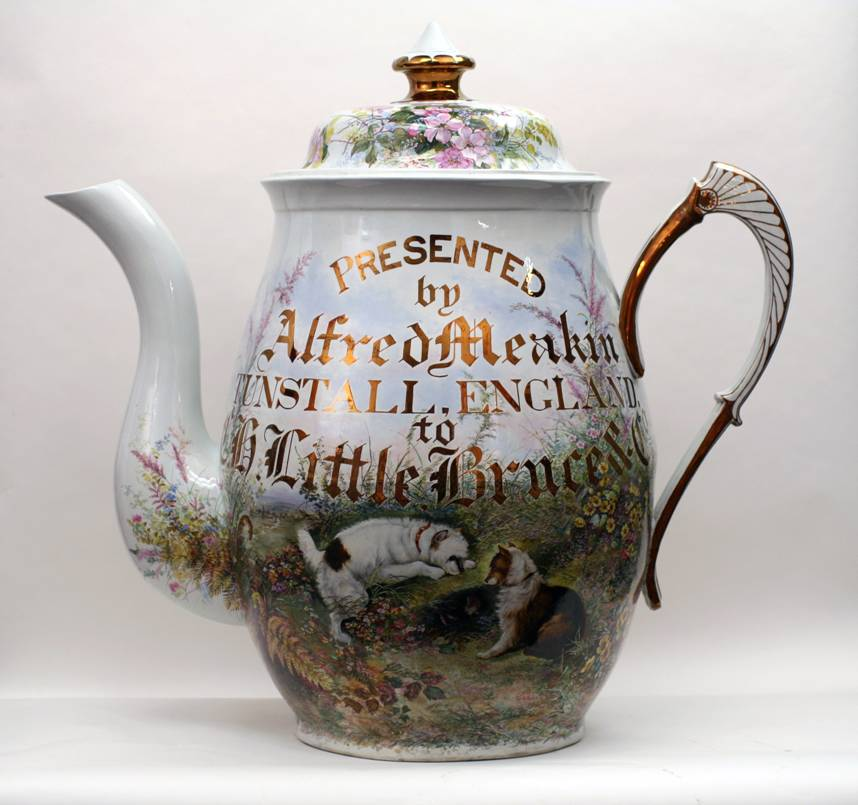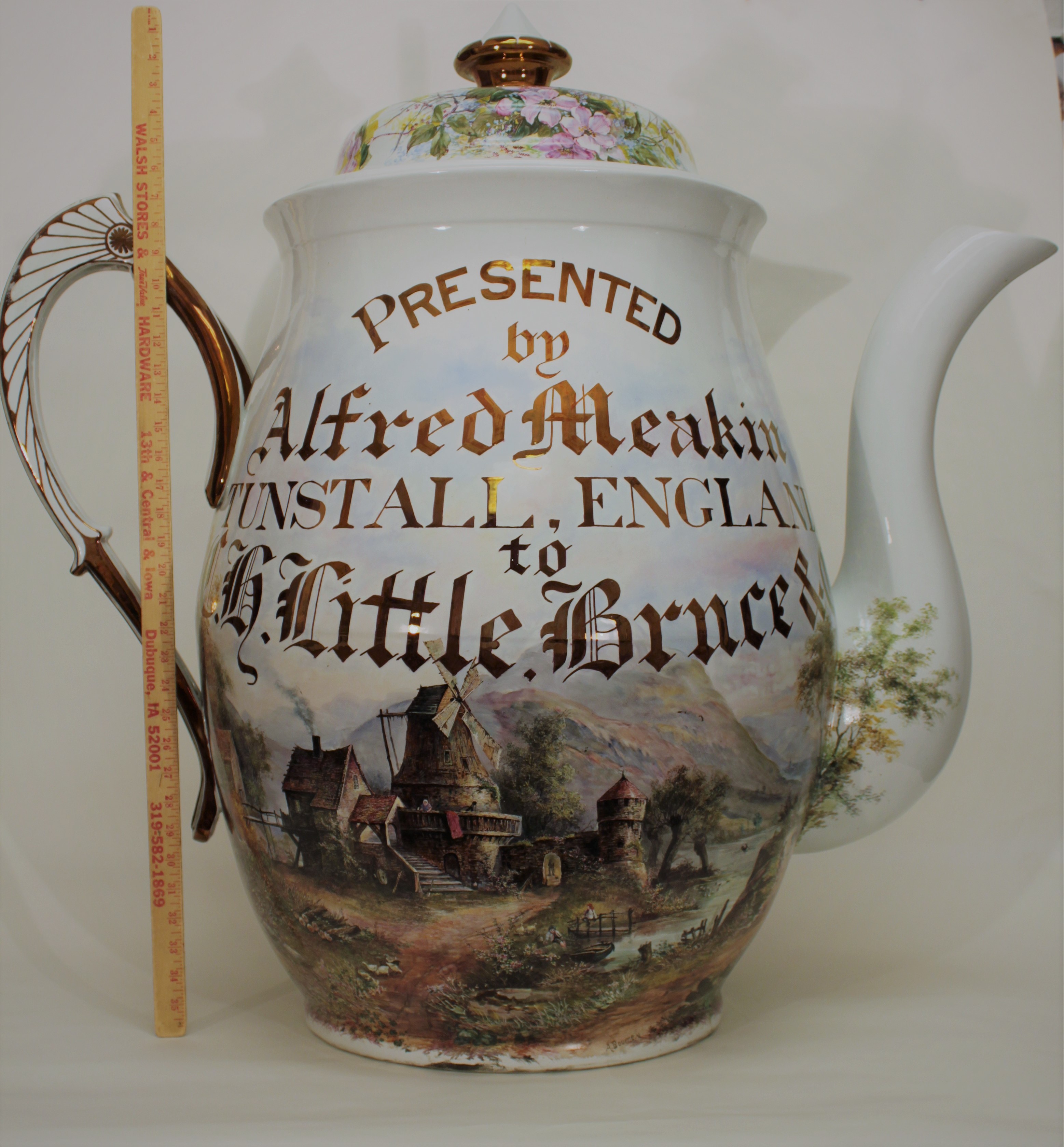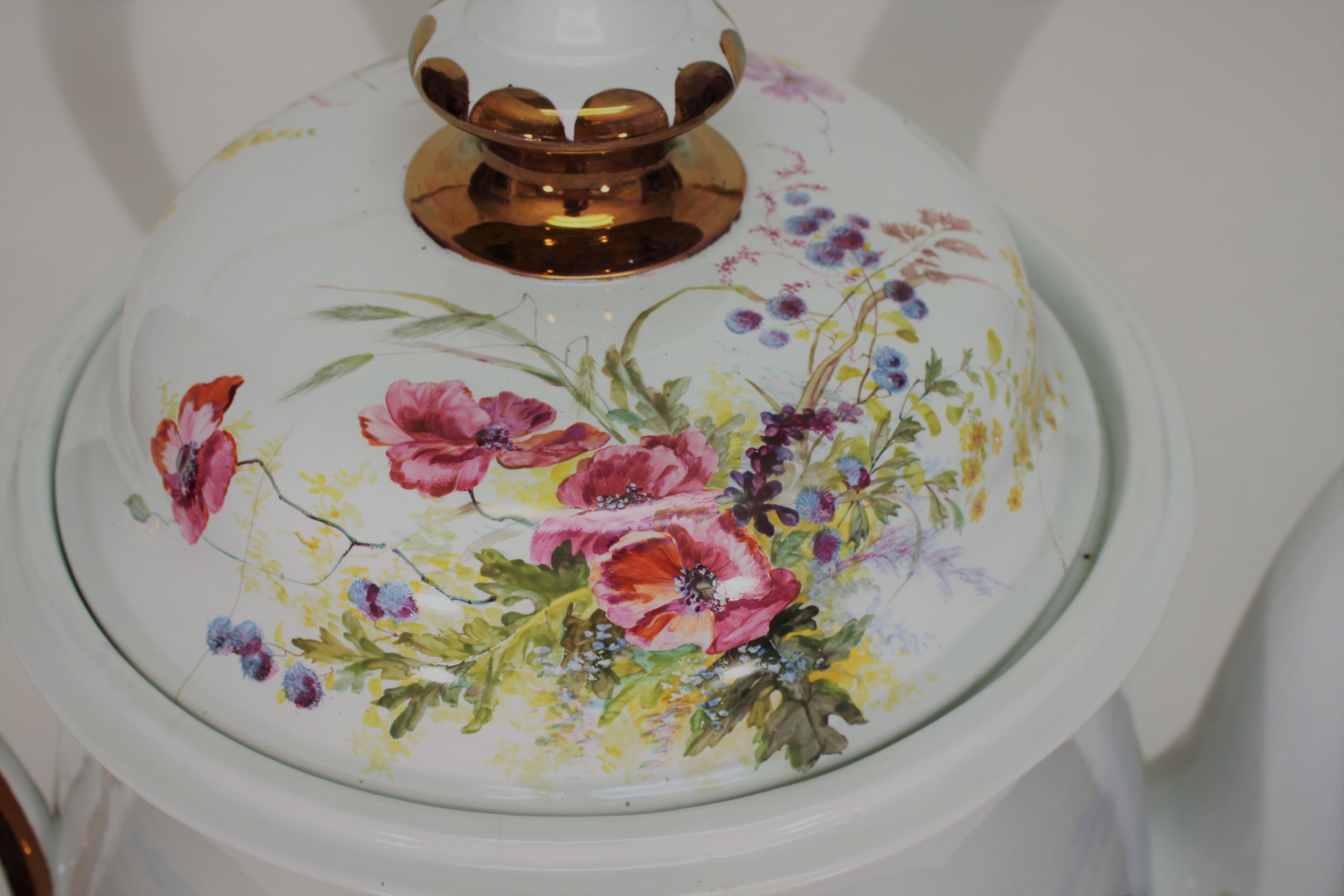Encyclopedia Dubuque
"Encyclopedia Dubuque is the online authority for all things Dubuque, written by the people who know the city best.”
Marshall Cohen—researcher and producer, CNN
Affiliated with the Local History Network of the State Historical Society of Iowa, and the Iowa Museum Association.
HOHNECKER'S: Difference between revisions
No edit summary |
No edit summary |
||
| Line 9: | Line 9: | ||
The "Dubuque" teapot was presented to C. H. Little, Bruce & Co. which was located at 537-545 Main Street in Dubuque Iowa, Bruce was a large importer of earthenware and china. A second teapot resides at the Cincinnati Museum Center, which was made for Dean and Kite Company. This teapot was damaged in a fire with most of the gold leaf burned off. The third teapot is in Springfield, Illinois and was presented to B. H. Ferguson. The handle is missing, having been broken off. | The "Dubuque" teapot was presented to C. H. Little, Bruce & Co. which was located at 537-545 Main Street in Dubuque Iowa, Bruce was a large importer of earthenware and china. A second teapot resides at the Cincinnati Museum Center, which was made for Dean and Kite Company. This teapot was damaged in a fire with most of the gold leaf burned off. The third teapot is in Springfield, Illinois and was presented to B. H. Ferguson. The handle is missing, having been broken off. | ||
C. H. Little Bruce & Co was purchased by | C. H. Little Bruce & Co was purchased by Becker-Hazelton, a competitor, on or about 1910. The teapot continued to reside at the Main Street location until 1914 when it was relocated to Becker-Hazelton's new building at 280-284 Iowa Street. When Becker-Hazelton liquidated in 1959, the remaining inventory and the teapot were purchased by G. J. Hohnecker Co. and moved to the company building at 395 South Main Street. The teapot was placed on display, being positioned on a large safe, for customers to admire. In February 1984, Mr. G. J. Hohnecker retired, selling the business, including the teapot, to his son, John G. Hohnecker, whose business was Hohnecker Inc. doing business as Hohnecker Gifts. In 1985, the teapot was moved to Hohnecker's new building located at 2200 John F. Kennedy Road in Dubuque. It remained on display until the store closed on June 1, 2014. It has since been in storage. | ||
The illustration on the teapot shows the exquisite beauty of the decoration which was hand painted by an artist employed by Alfred Meakin by the name of A. Bourne. | The illustration on the teapot shows the exquisite beauty of the decoration which was hand painted by an artist employed by Alfred Meakin by the name of A. Bourne. | ||
Revision as of 01:08, 23 February 2018
HOHNECKER'S. Hohnecker's was the successor of a long line of companies including C. H. Little and Company, C. H. LITTLE, BRUCE AND COMPANY, BECKER-HAZLETON COMPANY. In 1959 G.J. Hohnecker purchased the Becker-Hazleton Company. This one-of-a-kind teapot was an important part of the transaction.
The World's Largest Teapot
Dubuque, Iowa is the home of the largest teapot ever made! Holding 23 gallons, enough for 700 cups of tea, with a height of 37 inches and a circumference of 73 inches, this is truly a testimony to the craftsmen who created it! The history of why it was made and the story of how resides in Dubuque is fascinating!
Our story begins in Tunstall, Stoke-on-Trent England, where Alfred Meakin China was founded in 1875. Tunstall was a world renown pottery manufacturing center, with numerous pottery factories, exporting millions of pieces of pottery and dinnerware annually across the globe. There was stiff competition among potteries, not only for customers, but for the potters themselves, who wanted to highlight their skills. In the 1880s, several potteries started a competition to see who could make the largest teapot. As you can imagine, the technical difficulties to make and fire such a large piece were a challenge to overcome. The finished teapots would be exhibited at various trade shows and some were given to their better distributors. The teapot would be hand painted with highly detailed scenes and signed by the artist. Alfred Meakin, it is believed, created about twelve large teapots, of which there are three known to have survived. When Alfred Meakin presented teapots to their distributors, the name of the recipient was painted in gold leaf.
The "Dubuque" teapot was presented to C. H. Little, Bruce & Co. which was located at 537-545 Main Street in Dubuque Iowa, Bruce was a large importer of earthenware and china. A second teapot resides at the Cincinnati Museum Center, which was made for Dean and Kite Company. This teapot was damaged in a fire with most of the gold leaf burned off. The third teapot is in Springfield, Illinois and was presented to B. H. Ferguson. The handle is missing, having been broken off.
C. H. Little Bruce & Co was purchased by Becker-Hazelton, a competitor, on or about 1910. The teapot continued to reside at the Main Street location until 1914 when it was relocated to Becker-Hazelton's new building at 280-284 Iowa Street. When Becker-Hazelton liquidated in 1959, the remaining inventory and the teapot were purchased by G. J. Hohnecker Co. and moved to the company building at 395 South Main Street. The teapot was placed on display, being positioned on a large safe, for customers to admire. In February 1984, Mr. G. J. Hohnecker retired, selling the business, including the teapot, to his son, John G. Hohnecker, whose business was Hohnecker Inc. doing business as Hohnecker Gifts. In 1985, the teapot was moved to Hohnecker's new building located at 2200 John F. Kennedy Road in Dubuque. It remained on display until the store closed on June 1, 2014. It has since been in storage.
The illustration on the teapot shows the exquisite beauty of the decoration which was hand painted by an artist employed by Alfred Meakin by the name of A. Bourne.
On one side, the picture centers around a windmill beside a small lake in which there is a boat and a small boy fishing on the bank. Accompanying this boy is a small girl leading two geese. Although windmills are generally associated with Holland, the windmill pictured is no doubt in England, because the English influence is obvious in the architecture of the mill owners' cottage. The mill was evidently used to grind grain because on one side of the painting there is a road on which a man is on his way to the mill, leading a mule on whose back is seated a woman with a bag of grain. In the hazy blue distance, a small village with its church steeple is seen.
On the other side of the teapot there is an entirely different painting. Shown here are two small dogs waiting to pounce upon a small rabbit who is seen sitting in its burrow. Although the picture on this side of the teapot is nearly life-size, the paintings are so skillfully joined by the artist that the difference in the size of the subjects is virtually unnoticed as one goes from one side of the teapot to the other. The cover is a beautiful floral picture that also fits into both scenes without the difference in size of the details being noticed.
To create a teapot of this size, with its hollow spout, is an amazing accomplishment! To the layman, it may be a curiosity, but to the potter, interest is centered largely in his knowledge of the infinite patience and expert care demanded in its manufacture. He knows what a real feat it represents in potting, firing and glazing.
As one can appreciate, with such a unique work of art, lore has appeared, some true, some false. It was once thought, but later debunked, that the teapot was hung outside of C. H. Little Bruce as a sign. The teapot broke loose and crashed down narrowly missing a passerby on the sidewalk! The teapot allegedly was replaced by Meakin with a new one. This was a fairy tale on several counts. Why would you hang a work of art outside in the Iowa Weather? How would you mount it? The molds were likely destroyed and therefore a replacement could not be manufactured.
However, one true story is that Becker-Hazelton did use the teapot as a display to attract customers at various trade shows around the Midwest. These trade shows mainly occurred in the 1930s, and with all its travels, never received a scratch!
Another true story is that in 1959 Mr. G. J. Hohnecker was asked to purchase the remaining inventory of Becker-Hazelton "without" the teapot. But Mr. Hohnecker, with the insistence of his wife, Coletta, refused to buy the inventory if the teapot was not included. Becker-Hazelton conceded, and sold the teapot for $100. Another true story is that in 1980 while on display at 395 South Main, perched on top of the safe, the store was burglarized. The burglars peeled the front of the safe while the teapot sat upon it. Amazingly, the teapot was unharmed! John Hohnecker, upon discovering the break in, called his father to tell him that the safe was destroyed, but to their relief, the teapot was miraculously unharmed! This was the its closest call to doom! One more story occurred in 1984. A leak appeared in the ceiling above the teapot. Water was dripping on the lid and running in between the lid and the body. After the lid was removed, much to the surprise of everyone, the teapot had about a foot of water inside, but no damage was done.
Thousands of people have admired this unique work of art, the beautiful painting of the English countryside, combined with the gifts of skilled potters who molded and fired it. Their legacy lives on!
---
Source:
John Hohnecker G. J. Hohnecker The Potteries Museum & Art Gallery Andrew Richmond, Garths Auctioneers Cincinnati Museum Center




